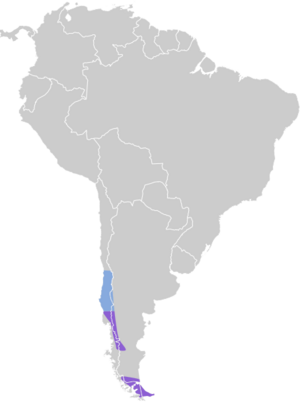Austral canastero facts for kids
Quick facts for kids Austral canastero |
|
|---|---|
 |
|
| Conservation status | |
| Scientific classification | |
| Genus: |
Asthenes
|
| Species: |
anthoides
|
 |
|
The austral canastero (scientific name: 'Asthenes anthoides') is a type of bird. It belongs to the ovenbird family called Furnariidae. These birds are known for building interesting nests. You can find the austral canastero living in Argentina and Chile.
Contents
About the Austral Canastero
The austral canastero has had a few different scientific names over the years. But since the mid-1900s, scientists have mostly agreed to place it in the Asthenes group. This bird is monotypic, meaning it's the only species in its group. It is also closely related to the Hudson's canastero.
The name "austral" means "southern," which refers to where this bird lives. Its scientific name, anthoides, means it looks a bit like pipits, which are birds from the Anthus group.
What Does the Austral Canastero Look Like?
The austral canastero is about 15.5 to 16.5 centimeters (6 to 6.5 inches) long. It weighs around 21 to 23 grams (0.7 to 0.8 ounces). This makes it one of the smallest canasteros.
It has a plain look with dark stripes on its back. Its tail is shorter than many other canasteros. Both male and female birds look alike. However, there can be small differences between individual birds.
Adult birds have a light, whitish stripe above their eyes. Their face is sandy brown with dark patches near their beak. Their head, back, and rump are sandy brown with clear blackish stripes.
Their wings are brownish. The feathers covering the wings are cinnamon to brown. The main flight feathers are dark and dusky. The central tail feathers are dark olive-brown. The other tail feathers are mostly dark with whitish tips.
The chin of the bird is whitish. Sometimes it has a light orange-red patch. Its throat, chest, and belly are whitish or very light sandy brown. There are some blackish stripes on the sides of its chest.
The austral canastero has black eyes. Its beak is black with a whitish bottom part. Its legs and feet can be pink or dusky gray. Young birds have blackish-brown stripes on their chest and sides.
Where Does the Austral Canastero Live?
The austral canastero lives in different areas, not all connected. In Chile, you can find it from the Coquimbo Region south to the Aysén Region. It also lives in southern Magallanes Region and on Tierra del Fuego.
In Argentina, it lives from Neuquén Province south to Chubut Province. It is also found from southern Santa Cruz Province onto Tierra del Fuego.
This bird mostly lives in moist shrub-steppe areas. These places have tall shrubs and tussock grass. It can also be found in more open scrublands with less grass. Sometimes, it lives in Nothofagus woodlands. It avoids grasslands that have no shrubs or trees.
It usually lives from sea level up to about 200 meters (650 feet) high. But sometimes, it has been seen as high as 1,750 meters (5,740 feet).
How Does the Austral Canastero Behave?
Movement and Migration
Some austral canasteros from the northern areas move around. After breeding, birds from both sides of the southern Andes mountains mostly fly north. They go into central Chile. At this time, you can see more of them near the coast. They are also found inland.
The birds living in the southern parts of Patagonia and on Tierra del Fuego seem to stay there all year. They do not migrate.
What Does the Austral Canastero Eat?
The austral canastero eats arthropods, which are small creatures like insects and spiders. It usually looks for food alone or in pairs. It picks up prey from the ground and from shrubs. Sometimes, it pushes into clumps of grass to find food.
Breeding and Nests
The austral canastero breeds in southern Chile and Argentina. This happens during the southern spring and summer. This is roughly between October and February. We don't know much about its breeding season in other places.
Scientists believe these birds are monogamous, meaning they have one partner. They build a round nest using thorny sticks. The nest has an entrance on the side. Inside, they line it with soft plant material. The nest is usually placed inside or under a shrub.
They lay two eggs at a time. We don't know how long the eggs take to hatch. We also don't know how long it takes for the young birds to leave the nest. Details about how the parents care for their young are also unknown.
What Does the Austral Canastero Sound Like?
The song of the austral canastero is a "short rising trill." It repeats this sound several times with a few seconds in between. It mostly sings during the breeding season. It sings in the morning and late afternoon. It usually sings from the top of a small bush.
Its call is a "very short metallic tick." It repeats this sound in a loose series.
Conservation Status
The IUCN (International Union for Conservation of Nature) first looked at the austral canastero in 1988. They listed it as Threatened. Then in 1994, it was listed as Vulnerable. But since 2004, it has been listed as "Least Concern." This means it is not currently at high risk of extinction.
The bird lives across a large area. Even though we don't know its exact population size, it is believed to be stable. There are no immediate threats that scientists have found. It is considered uncommon in some places and common in others.
One main concern is the change of shrub areas for grazing animals. This can be a threat because the bird needs shrubs to live.


